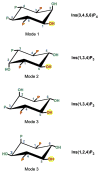Molecular basis for the integration of inositol phosphate signaling pathways via human ITPK1
- PMID: 19200440
- PMCID: PMC4770455
- DOI: 10.1016/j.advenzreg.2008.12.008
Molecular basis for the integration of inositol phosphate signaling pathways via human ITPK1
Figures




Similar articles
-
Human ITPK1: a reversible inositol phosphate kinase/phosphatase that links receptor-dependent phospholipase C to Ca2+-activated chloride channels.Sci Signal. 2008 Jan 29;1(4):pe5. doi: 10.1126/stke.14pe5. Sci Signal. 2008. PMID: 18272466 Review.
-
Integration of inositol phosphate signaling pathways via human ITPK1.J Biol Chem. 2007 Sep 21;282(38):28117-25. doi: 10.1074/jbc.M703121200. Epub 2007 Jul 6. J Biol Chem. 2007. PMID: 17616525 Free PMC article.
-
Roles of inositol phosphates and inositol pyrophosphates in development, cell signaling and nuclear processes.Adv Enzyme Regul. 2010;50(1):324-37. doi: 10.1016/j.advenzreg.2009.12.002. Epub 2009 Dec 16. Adv Enzyme Regul. 2010. PMID: 20006638 Free PMC article. Review. No abstract available.
-
Expression of inositol 1,3,4-trisphosphate 5/6-kinase (ITPK1) and its role in neural tube defects.Adv Enzyme Regul. 2010;50(1):365-72. doi: 10.1016/j.advenzreg.2009.10.017. Epub 2009 Nov 13. Adv Enzyme Regul. 2010. PMID: 19914276 Free PMC article. No abstract available.
-
ITPK1 mediates the lipid-independent synthesis of inositol phosphates controlled by metabolism.Proc Natl Acad Sci U S A. 2019 Dec 3;116(49):24551-24561. doi: 10.1073/pnas.1911431116. Epub 2019 Nov 21. Proc Natl Acad Sci U S A. 2019. PMID: 31754032 Free PMC article.
Cited by
-
Necroptosis-Related Gene Signature Predicts Prognosis in Patients with Advanced Ovarian Cancer.Cancers (Basel). 2025 Jan 15;17(2):271. doi: 10.3390/cancers17020271. Cancers (Basel). 2025. PMID: 39858052 Free PMC article.
-
Inositol trisphosphate 3-kinases: focus on immune and neuronal signaling.Cell Mol Life Sci. 2010 Jun;67(11):1755-78. doi: 10.1007/s00018-009-0238-5. Epub 2010 Jan 12. Cell Mol Life Sci. 2010. PMID: 20066467 Free PMC article. Review.
-
Lipid signaling in T-cell development and function.Cold Spring Harb Perspect Biol. 2010 Nov;2(11):a002428. doi: 10.1101/cshperspect.a002428. Epub 2010 Oct 13. Cold Spring Harb Perspect Biol. 2010. PMID: 20943760 Free PMC article. Review.
-
Serine protease activities in Leishmania (Leishmania) chagasi promastigotes.Parasitol Res. 2010 Oct;107(5):1151-62. doi: 10.1007/s00436-010-1983-y. Epub 2010 Jul 29. Parasitol Res. 2010. PMID: 20668879
-
SnapShot: Inositol phosphates.Cell. 2010 Dec 10;143(6):1030-1030.e1. doi: 10.1016/j.cell.2010.11.045. Cell. 2010. PMID: 21145466 Free PMC article. No abstract available.
References
-
- Abdullah M, Hughes PJ, Craxton A, Gigg R, Desai T, Marecek JF, et al. Purification and characterization of inositol 1,3,4-trisphosphate 5/6-kinase from rat liver using an inositol hexakisphosphate affinity column. J Biol Chem. 1992;267:22340–5. - PubMed
-
- Adelt S, Plettenburg O, Dallmann G, Ritter FP, Shears SB, Altenbach H-J, et al. Regiospecific phosphohydrolases from dictyostelium as tools for the chemoenzymatic synthesis of the enantiomers D-myo-inositol 1,2,4-trisphosphate and D-myo-inositol 2,3,6-trisphosphate: non-physiological, potential analogues of biologically active D-myo-inositol 1,3,4-trisphosphate. Bioorg Med Chem Lett. 2001;11:2705–8. - PubMed
-
- Alcazar-Roman AR, Wente SR. Inositol polyphosphates: a new frontier for regulating gene expression. Chromosoma. 2008;117:1–13. - PubMed
-
- Barg S, Huang P, Eliasson L, Nelson DJ, Obermüller S, Rorsman P, et al. Priming of insulin granules for exocytosis by granular chloride uptake and acidification. J Cell Sci. 2001;114:2145–54. - PubMed
Publication types
MeSH terms
Substances
Grants and funding
LinkOut - more resources
Full Text Sources

